
Boyacá is one of the thirty-two departments of Colombia, and the remnant of Boyacá State, one of the original nine states of the "United States of Colombia".

Department of Cundinamarca is one of the departments of Colombia. Its area covers 22,623 square kilometres (8,735 sq mi) and it has a population of 2,919,060 as of 2018. It was created on August 5, 1886, under the constitutional terms presented on the same year. Cundinamarca is located in the center of Colombia.
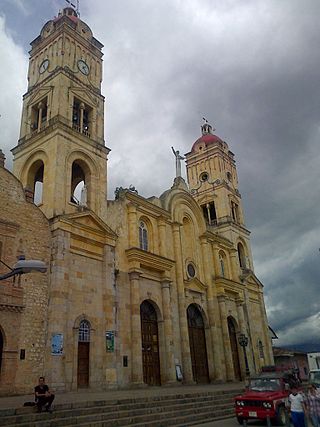
La Mesa is a municipality and town of Colombia in the Tequendama Province of the department of Cundinamarca. The urban centre is located 65 kilometres (40 mi) from Bogotá.
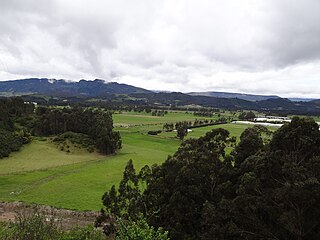
Central Savanna Province is one of the fifteen provinces of Cundinamarca, in Colombia. It is located in the central area of the department, and has 11 municipalities. The province capital is the city of Zipaquirá.

Almeidas Province is one of the 15 provinces in the Cundinamarca Department, Colombia. Almeidas borders to the east with the Boyacá Department to the north with the Ubaté Province, to the west with the Central Savanna Province and to the south with the Guavio Province.

Lower Magdalena Province is one of the 15 provinces in the Cundinamarca Department, Colombia. Lower Magdalena borders to the west with the Magdalena River, the Departments of Tolima and Caldas, to the north with the Boyacá Department, to the east with the Rionegro Province and Gualiva Province, and to the south with the Central Magdalena Province.
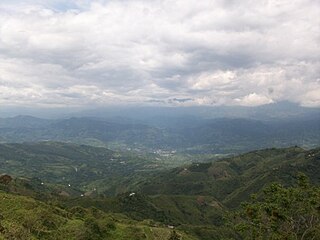
Gualivá Province is one of the 15 provinces in the Cundinamarca Department, Colombia. Gualivá borders the Lower Magdalena Province to the west, to the north the Rionegro Province, to the east and southeast the Western Savanna Province, to the south slightly the Tequendama Province and to the southwest the Central Magdalena Province.

The Guavio Province is one of the 15 provinces in the Cundinamarca department, Colombia. Guavio borders the Capital District of Bogotá and the Central Savanna Province to the west, to the north the Almeidas Province, to the east the Boyacá Department and Medina Province and to the south the Meta Department and the Eastern Province. The Alberto Lleras Dam is also located in this area. The eastern municipalities Gachalá and Ubalá are rich in emeralds.

Central Magdalena Province is one of the 15 provinces in the Cundinamarca Department, Colombia. Central Magdalena borders to the west the Tolima Department and the Magdalena River, to the north the Lower Magdalena Province, to the east the Gualivá and Tequendama Provinces and to the south the Upper Magdalena Province.
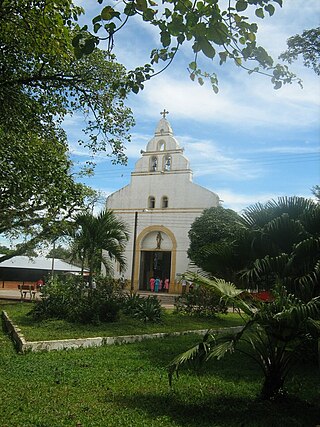
Medina Province is one of the 15 provinces in the Cundinamarca Department, Colombia. Medina borders to the west the Guavio Province, to the north, northeast and east the Boyacá Department and to the southeast and south the Meta Department.
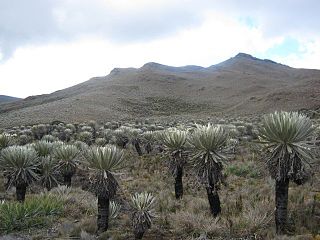
Eastern Province is one of the 15 provinces in the Cundinamarca Department, Colombia.

Soacha Province is one of the 15 provinces in the Cundinamarca Department, Colombia. Soacha is considered the only borough in the country, and a part of Bogotá, but legally the Colombian Republic considers it a municipality.

Ubaté Province is one of the 15 provinces in the Cundinamarca Department, Colombia.
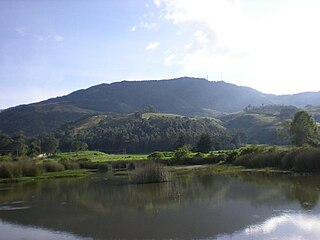
Western Savanna Province is one of the 15 provinces in the Cundinamarca Department, Colombia.
The Republic of Gran Colombia was a former independent country in northern South America, a post-Spanish colonial country that existed from 1819 to 1831. Its initial subdivisions, created in 1820, were revised and expanded in 1824 to 12 departments.

The province of Santafé de Bogotá, also known as the government of Santafé during the Spanish imperial era, was originally an administrative and territorial entity of the New Kingdom of Granada. It was created on July 17th, 1550, at which point New Granada was a province within the Viceroyalty of Peru. In 1717, province became part of Viceroyalty of New Granada after King Philip V of Spain issued a real cédula creating the new viceroyalty.

The Panche or Tolima is an indigenous group of people that lived in what is now Colombia. Their language is unclassified – and possibly unclassifiable – but may have been Cariban. They inhabited the southwestern parts of the department of Cundinamarca and the northeastern areas of the department of Tolima, close to the Magdalena River. At the time of the Spanish conquest, more than 30,000 Panche were living in what would become the New Kingdom of Granada. Early knowledge about the Panche has been compiled by scholar Pedro Simón. According to the latter, the word panche in their own Panche language means "cruel" and "murderer".

The Sumapaz River is a major tributary of the Magdalena River in Colombia. The 95 kilometres (59 mi) long river originates in the Eastern Ranges of the Colombian Andes at the largest páramo in the world; Sumapaz, of which it takes its name. It forms the natural boundary between the departments of Cundinamarca and Tolima.

Ada María Magdalena Sierra is an Argentine architect and politician who served as a National Deputy from 2017 to 2021, elected in Buenos Aires Province. A member of the Justicialist Party, she was elected in 2017 as part of Unidad Ciudadana. Sierra previously served as a member of the Buenos Aires Province Senate from 2015 to 2017, representing the Third Electoral Section. Since 2021, she has been a member of the City Council of Avellaneda, a post she previously held as well.

















